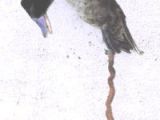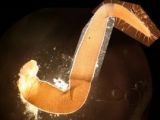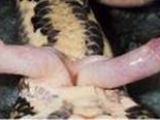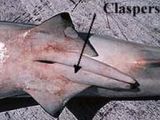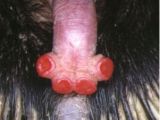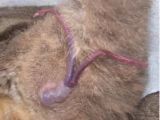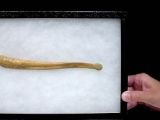Penises are strongly connected to the war between sexes. Only animals with internal fecundation have a penis, no matter if they lay eggs or deliver living offspring. A penis' main goal is to insert the sperm inside the female body to fertilize the eggs.
Internal fecundation is a must for terrestrial breeding animals but it also evolved in some aquatic lineages: cephalopods (squids, octopuses, cuttlefish), snails (the terrestrial ones, too), crustaceans (only some of them) and sharks.
On land, insects, spiders, snails, reptiles, birds (just a few) and mammals have penises. With a penis, the male controls the fertilization process. But a female too controls it more, as mating turns more complicated and she can decide somehow which partner she will choose.
1. This top could have started only with the largest penis in the world. Elephants and odd hoofed mammals (like rhinos and horses) have huge penises, that can be 1.5 m (5 ft) long, but actually the biggest penis belongs to the biggest animal: the blue whale. The largest penis (belonging to a blue whale) ever measured had 2,4 m (8 feet).
Accurate measurements are difficult to be made because the whale's erect length can only be observed during mating. Moreover, whales (and dolphins) have some control over their penises: they can move it and - to a certain degree - bend its tip to facilitate mating!
Still, if we take into consideration the whale's size, this is like a human showing off a 10 cm penis, as the blue whale can reach 33 m (100 feet) body length.
2. Most birds do not have a penis. Only ostriches (and related groups, like kiwi and tinamous), ducks, geese and swans have it. And what penises do they hide curled into their cloacae!
The Argentine Blue-bill or Argentine Lake Duck (Oxyura vittata) can have 42.5 cm (17 inches) long penises, at an average body length of 20 cm (8 inches)!
This is like humans possessing a 3.5 m (12 feet) penis... This is the largest penis amongst vertebrates related to body size.
Biologists believe that the remarkable size of this penis may have evolved in response to competitive pressure in these highly promiscuous species, removing sperm from previous matings in the manner of a bottlebrush.
Moreover, ducks' penises are very bizarre: beside their size, they are extremely variable in shape, from smooth to covered with spines, grooves and variably curled, and the duck vagina anatomy is just as bizarre.
3. There is a type of crustacean (crab related animals) - called barnacles - providing a huge surprise. Barnacles look more like small shells and are indeed sedentary animals, living fixed on rocks or man-made structures (or sometimes even on whales) with a muscular stalk or not. Gooseneck barnacle is a very expensive seafood! Like many sedentary animals, barnacles are hermaphroditic and alternate male and female roles over time.
Neighboring barnacles interfecundate between them and to be able to do this, they employ the relatively longest penis in the animal kingdom: it is 40 times longer than the animal's body.
As the barnacles measure just a few cm, their penises won't be so obvious for humans...
4. If we take a look at cephalopods, the male is really a tab of the penis. In some species, females' only contact with the male side is with their penises! The penis literally detaches itself from the male body and copulates the female...
The cephalopod penises are named hectocotylus, even when they are not removable, like in the cases of squids and cuttlefish. It is the third tentacle on the right of the male that is modified in various ways to effect the fertilization of the female's eggs and stores spermatophores (packages of sperm cells).
After one mating, when the male loses its hectocotylus, it won't be able to copulate again till the next season, when a new hectocotylus re-grows. In common octopuses, males die within a few months after mating, without regenerating another hectocotylus.
Sometimes, the hectocotylus can even lose its tentacle form and the males of those species seem to have only seven tentacles.
In Argonauta octopuses, the much smaller male does not even approach the female. When the spermatophores are formed, the hectocotylus breaks off from the male while away from the female, heading towards her and entering alone into its mantle cavity to copulate.
There is another mystery unsolved: if giant squids had arms longer than 8 m (25 feet), how big would their hectocotylus be?
5. Snakes and lizards have a ... double penis. Each penis on this pair is called a hemipenis (plural hemipenes).
Resting hemipenes are held inverted inside the cloacae and during the copulation act, the erectile tissue, like that in the mammalian and human penis, everts the hemipenes in erection. Despite this nature's generosity, only one "gun" is used at a time and scientific research revealed that males alternate the use of their weaponry between copulations.
This is because every hemipenis also ejaculates a gelatinous "mating plug", which delays remating by female and continuous use of only one arm would deplete it of ammunition.
In many snakes, the hemipenis possesses spines or hooks, in order to anchor the male inside the female, as the lack of legs impedes males from gripping the females. As if this had not been enough, some species even have forked hemipenes (each hemipenis has two tips).
Because hemipenes are everted and inverted, their anatomical structure is not like that of the mammal penis: they do not have a completely enclosed channel for sperm conduction, but a seminal groove which seals as the erectile tissue expands the hemipenes. In snakes, where there is an asymmetry between many paired organs (kidney, testes), there is an asymmetry between the hemipenes as well.
In some lizards, the distal lobes of the retracted hemipenis are complexly folded and there is a well-defined supporting structure of dense connective tissue, the armature.
6. Sharks too possess a double penis. All other fish species have an external fecundation (like we see in most frogs and toads), in which a penis would be useless. (the sole exception amongst the bony fish is the Poeciliidae family and some related species, tiny tropical species, some very common in fish tanks, like gupy, molly, platy, swordtail).
This does not mean that all sharks will give birth to living offspring, some lay eggs (like all rays, skates, Port Jackson shark, catsharks, houndsharks). The two penises of the shark are named claspers (or pterygopodia) and develop themselves based on the anterior region of the ventral flippers. The name "claspers" is somewhat misleading as they do not serve for holding on to the female, but play the role of the mammalian penis.
Each of the two penises has a cartilaginous support inside and a groove on their inner edge. Unlike the case of the double penis of the snakes and lizards, where each of the penises functions alone like a sole penis by itself, in this case, they approach each other and unite during the copulation, forming a channel through which the sperm liquid is eliminated.
In small species, like catfish shark, males were seen curled around the females. Less flexible species were seen in a parallel position, with the male introducing a clasper in the female's oviduct. Females in large species (like great white) bear bite marks that seem to be inflicted by mating males, in order to get a grip for maintaining position. On the gill area, females present a thickened skin, to withstand the bites (as seen in great white shark female).
7. Human penis ends with a head called gland. This is also the case of most species.
But some glands are double-headed! Bifurcated penises are found in the most primitive living mammals: monotremes (which include platypus and echidna) and marsupials (opossums, Tasmanian devils, quolls, bilbies, bandicoots, koala, wombats, wallabies, potoroos, numbat, gliders and others). Amongst marsupials, only the two largest species of kangaroos are destitute of this peculiar trait. The bifurcated penises are formed by two distinct columns and so the penis has two ends. And to get more, the echidna has a four-headed penis!
Echidna does not use its penis for urination and it only gets out of the body during mating (monotremes have a cloacae organ, like birds and reptiles, where the penis is kept while resting). The two penis heads may have different anatomies, according to the groups and species: some are short, others long, some are coiled between them and so on.
Because the peculiar penis' anatomy in males corresponds to an odd female genital anatomy, the marsupial females do not only have two uteruses (which are partially or totally fused in evolved mammals) but two vaginas also! In some species, the vaginas may be partially joined, but never lose identity.
8. The penis has a very simple job to do: to maintain sufficient stiffness to enter an orifice during mating and to deliver sperm. That's it. Mammals solved it in the easiest way!
Most mammals have a unique bone called baculum (also penis bone, penile bone or os penis) in their penis. The only mammal species without baculum are the humans, horses, donkeys, rhinoceros, marsupials, rabbits, cetaceans (whales and dolphins), elephants and hyenas.
But baculum is present in most primates, rodents, carnivores, seals. The penis bone is kept in the abdomen and, when needed, a set of muscles push it into a sheath in the fleshy part of the penis. It enters the erectile tissue, providing rigidness to aid during the copulation. The penis bone varies in size and shape and its characteristics are sometimes used to differentiate between similar species. The homologue of the baculum in female mammals is known as the baubellum or os clitoris.
In humans and mammals lacking the baculum and baubellum, the rigidity of the erection is provided entirely through blood pressure in the corpus cavernosum. This bone is important in copulation when mates have only a short encounter and need to perform quickly.
The baculum is for speed: sliding a bone in and out of a sheath is much faster than waiting for the hydraulics to kick in and limits the time spent for mating, which is, after all, in a vulnerable position.
Indeed, mammals without a baculum have in change larger erectile penises and they perform much longer during copulation! .... The baculum explains lion's sexual marathon of roughly 250 copulations in 4 days, even if each copulation lasts 30-70 seconds ....Because, in this case, erection depends more on a willingly moved muscle and not in tissue turgescence.
The largest baculum in the mammal kingdom belongs to the walrus, which can reach a length of 30 inches (75 cm): as big as a human femur! Even large dogs have a 10 cm baculum! In Chinese traditional medicine, tiger and bear bone penises are considered aphrodisiacs! (chewing chicken bones would result cheaper, with the same effects and would not push to the brink of extinction these species).
9. The penis of the vertebrates and cephalopods, being fleshy, cannot fossilize. The shark's penis has cartilages, but these seldom fossilize. Perhaps only the mummified penises of the pharaohs are the only fleshy ones that can come from the past. The baculum is not attached to the skeleton and hard to find in fossils. Still, fossils of cave bear penis bones have been found.
In fact, only in arthropods (like crustaceans, spiders, insects), as their penis has an exoskeleton, there are real chances of finding fossil penises. Indeed, the oldest fossil penis is that of an ocean-dwelling ostracode crustacean, Colymbosathon ecplecticos ("amazing swimmer with a large penis"), found in 2003 in the 425-million-year-old rocks in the UK. The 5 mm long ancient creature had been buried in volcanic ash during the Silurian Period and had been well preserved, his soft tissues included, being remarkably similar to some modern ostracodes.
A remarkable old male genitalia was found in the 400-million-year-old fossil of a harvestman or daddy longlegs, a non-web-spinning arachnid, related to mites, ticks and spiders. This 2001 find was discovered in rocks from the village of Rhynie, near Aberdeen in Scotland. Despite the great age of the fossils, they are almost identical to current harvestmen. This is the oldest penis in a terrestrial species to be found.
10.We, humans, may not be endowed by nature with great physical abilities: powerful muscles or weaponry-like fangs, claws, horns and so on. But there is one chapter where we excel: sex.
I'm not talking about sexual activity - at it has been proved that bonobo (which is also wrongly named "dwarf chimpanzee") has more sex and much varied than the human being - but about penis size.
Man is the ape, the monkey and the primate with the biggest penis!
Gorilla males, which are dwarf humans in size, have minute penises compared to ours, as thicker and longer as a pencil. Other apes do not reach even this size. In some African countries, saying that one is 'hung like a gorilla' is a great insult.
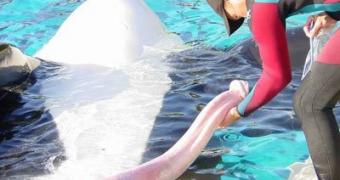
 14 DAY TRIAL //
14 DAY TRIAL // 
